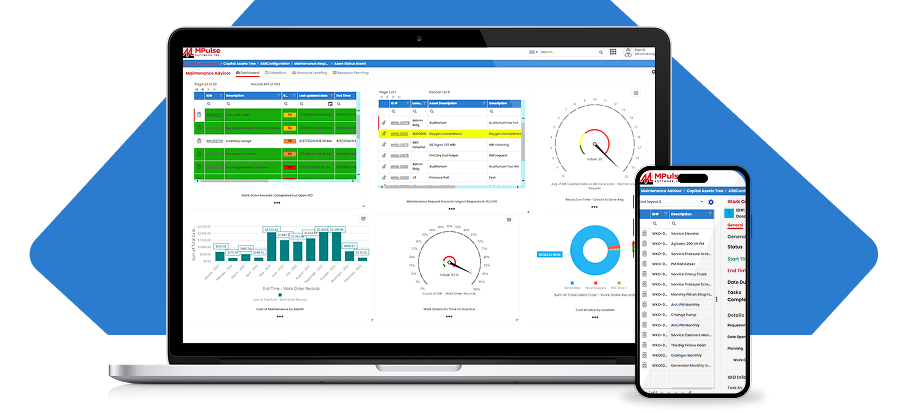In the competitive manufacturing industry, cost control can make a big difference in the bottom line. But the bean counters often overlook simple solutions to save money.
It’s no secret that many organizations undervalue the power of maintenance in both improving productivity and controlling costs. That leaves an opportunity for proactive manufacturers to reap the benefits of CMMS software and the benefits it offers.
Implementing a maintenance strategy can help manufacturers forecast and control long-term maintenance costs. By planning and budgeting for maintenance activities, they can avoid sudden financial shocks due to key asset failures.
CMMS for Manufacturing Costs
The potential for cost saving with CMMS in manufacturing applies to both equipment and facility maintenance. Opportunities include improving maintenance processes, reducing downtime, optimizing equipment performance, boosting safety procedures, and enhancing overall operational efficiency. Let’s discuss the ten most common ways a CMMS can help you achieve these cost-saving benefits.
#1: Preventive Maintenance Optimization
Production equipment maintenance can prevent unexpected breakdowns and extend the lifespan of your assets. CMMS allows you to schedule and manage preventive maintenance tasks more effectively, which reduces the likelihood of costly emergency repairs and production interruptions.
While manufacturers make an upfront investment in preventive maintenance activities, this proactive approach usually is much more cost-effective than dealing with the consequences of equipment breakdowns. Unplanned downtime, emergency repairs, and replacement costs can far outweigh the expenses of routine maintenance.
#2: Reduced Downtime
CMMS helps manufacturers track and manage maintenance schedules, parts inventory, and work orders more efficiently. As a result, your maintenance team can respond faster when equipment requires maintenance or repairs, minimizing production downtime.
By collecting information and turning it into actionable data, CMMS software ensures your most important data is front and center, where you don’t have to dig for it. Plus, when things go wrong, your team has access to historical data, vendor information, videos, photos, documents, and websites at their fingertips.
#3: Inventory Management
Inventory management in manufacturing reduces storage costs and ensures that you’re not tying up excess capital in unnecessary inventory. CMMS helps by keeping track of spare parts and inventory levels. With accurate inventory data, you can implement just-in-time ordering, avoiding overstocking or understocking.
CMMS also can automate the ordering and replenishment process. Suppliers can be integrated into the system, receiving automatic notifications when parts need to be restocked. By streamlining the procurement process, you can strengthen the relationship between your team and your vendors by fostering reliability and trust.
#4: Workforce Efficiency
Reliable equipment leads to smoother production processes, reducing frustration and stress among your employees who rely on the equipment to perform their tasks. A well-maintained workplace also demonstrates the company’s commitment to employee safety and well-being.
CMMS streamlines work order management by helping you assign tasks to the right personnel and providing them with detailed instructions. You can also automate this process to enhance the productivity of your maintenance teams. Additionally, quick access to historical data can help your technicians decrease the time needed to diagnose and fix issues.
#5: Data-Driven Decision Making
Using a data-driven approach helps manufacturers make informed decisions about maintenance strategies and capital investments. CMMS collects and stores maintenance data, which you can use to identify patterns of equipment failures, maintenance costs, and overall equipment performance.
This data changes the way you make decisions because you have all the information at your fingertips to determine the total cost of ownership. Your company can make informed decisions about repairs, replacements, and equipment upgrades based on historical data.
#6: Energy Efficiency
Well-maintained equipment tends to operate more efficiently, consuming less energy. Manufacturing facility maintenance software can help track energy consumption data and identify opportunities for optimizing energy usage, leading to cost savings in the long run.
Regular maintenance also helps keep equipment operating at peak efficiency. This proactive approach translates to reduced energy consumption, optimized production processes, and ultimately, cost savings.
#7: Regulatory Compliance
Many industries have strict regulatory requirements for equipment maintenance and safety. CMMS ensures that maintenance tasks are performed according to regulations. Additionally, it documents every work order or scheduled maintenance task, helping you avoid potential fines or legal issues that could incur additional costs.
Properly maintained equipment is less likely to malfunction, which reduces the risk of accidents and injuries in the workplace. Regular maintenance also ensures that safety features on equipment are functioning effectively.
#8: Equipment Performance Monitoring
Advanced maintenance strategies, such as predictive maintenance using sensors and data analytics, allow manufacturers to predict when equipment components are likely to fail. CMMS can provide real-time data on equipment performance, allowing you to identify trends that might indicate impending failures.
By addressing issues before they escalate, you can avoid expensive repairs and unplanned downtime. Additionally, well-maintained equipment is more reliable and consistent in its performance, leading to consistent product quality, fewer defects, and improved customer satisfaction.
#9: Vendor Relationships
Maintenance software can store comprehensive information about vendors and contractors, including contact details, lead times, pricing agreements, and performance history. This information ensures that you have accurate and up-to-date data to facilitate communication and collaboration with suppliers.
CMMS also can help you keep track of maintenance contracts, warranties, and service agreements with equipment suppliers. As a result, your company can get the maximum value from these contracts and maintain strong supplier relationships.
#10: Long-Term Asset Management
Maintaining a detailed record of maintenance activities and equipment performance can lead to better asset management. Regular maintenance helps identify and address minor issues before they escalate into major problems, which extends the lifespan of the assets, reduces the need for frequent replacements, and decreases capital expenditures.
CMMS helps by tracking the complete lifecycle of equipment, from acquisition to retirement. This data allows you to make informed decisions about when to replace or upgrade equipment, thereby optimizing asset utilization and minimizing unnecessary spending.
A well-implemented CMMS can lead to improved maintenance practices, which contribute to lowering manufacturing costs over time.
MPulse can help you customize our solutions to your specific manufacturing environment, helping your organization maximize manufacturing CMMS benefits. Contact us or start a free trial.


